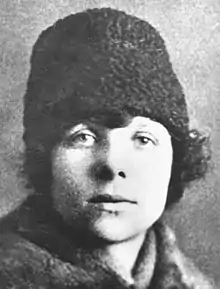May Picqueray
Marie Jeanne Picqueray, (July 8, 1898 – November 3, 1983) known as May Picqueray, was an anarchist activist, trade unionist, and notable pacifist.
May Picqueray | |
|---|---|
 | |
| Born | July 8, 1898 Savenay |
| Died | November 3, 1983 (aged 85) Paris |
| Known for | Anarchist activism, pacifism, anti-militarism, May 1968 protests |
From April 1974 to November 1983, she was the leading publisher of Le Réfractaire, a pacifist and anti-militarist periodical.
Biography
May Piqueray was born on July 8, 1898, in Savenay, France, to François-Jean-Marie Picqueray and Marie-Louise Françoise Leray. She spent her early years in Châteaubriant and Saint-Nazaire.
Attracted in her youth to revolutionary circles, May Picqueray left for Moscow, Russia in 1922, as a delegate of the Metalworkers union, which was at the time part of the Red Trade Union International. While she was in Moscow, she notably climbed on the table to denounce union congregants eating while the common people starved.[1] She also visited Vladimir Lenin, who was already weakened by the disease that eventually killed him. Because of Leon Trotsky's responsibility in the crushing of the Kronstadt rebellion, and his perceived betrayal of Nestor Makhno, she refused to shake his hand when she met him, even as she asked him to release the anarchists locked in prison by the Bolsheviks.[2]
During the trial of Sacco and Vanzetti, May Picqueray sent the US Embassy in France a booby-trapped package containing a defensive grenade and leaflets. This attack was aimed at getting French journalists to cover the trial, without causing anything other than property damage.[2]
By the time of the Spanish Civil War, May Picqueray had become a committed pacifist, and she joined the Spanish Aid Committee for Children to help transport Spanish orphans who were displaced by the war. She was in Toulouse at the time, where she took care of welcoming refugees.
An early feminist, May Picqueray lived as an independent woman without depriving herself of starting a family. She raised three children alone, born to three different fathers. Married in Saint-Nazaire on July 22, 1916, to Fred Schneyder, of Dutch nationality, she separated from him three weeks later. In 1923, she gave birth to a daughter, Sonia, conceived during her trip to Russia with Lucien Chevalier, federal secretary of the Federation of Metals. In August 1930, she married François Niel, with whom she had a son, Lucien. Finally, in 1941, in the midst of the war, she gave birth to a daughter, Marie-May, whom she had conceived with Isaac Gilman, a Bielo-Russian Jew who had taken refuge in Toulouse.
An enthusiastic participant in the uprising of May 1968, she participated in anti-nuclear campaigns and supported conscientious objectors and those who were resistant to military service.[3]
Le Réfractaire

An important figure in the French anarchist milieu, May Picqueray was the founder of the newspaper Le Réfractaire ("Libertarian organ for the defense of peace and individual freedoms"), which she published monthly from April 1, 1974 until her death on November 2, 1983. She was supported in her endeavours by many young conscientious objectors, artists, and designers.[1]
According to her will, May Picqueray was cremated at Père-Lachaise.
References
- Picqueray, May. (2019). My Eighty-One Years of Anarchy : a Memoir. Sharkey, Paul. Chico, CA: AK Press. ISBN 978-1-84935-323-6. OCLC 1085177590.
- Trasciatti, Mary Anne (June 2011). "The Sacco-Vanzetti Affair: America on Trial. By Moshik Temkin. (New Haven: Yale University Press, 2009. Pp. xii, 316. $35.00.)". The New England Quarterly. 84 (2): 352–355. doi:10.1162/tneq_r_00094. ISSN 0028-4866.
- Abidor, Mitchell (10 April 2018). May made me : an oral history of the 1968 uprising in France. [Chico, CA]. ISBN 978-1-84935-310-6. OCLC 1006314267.